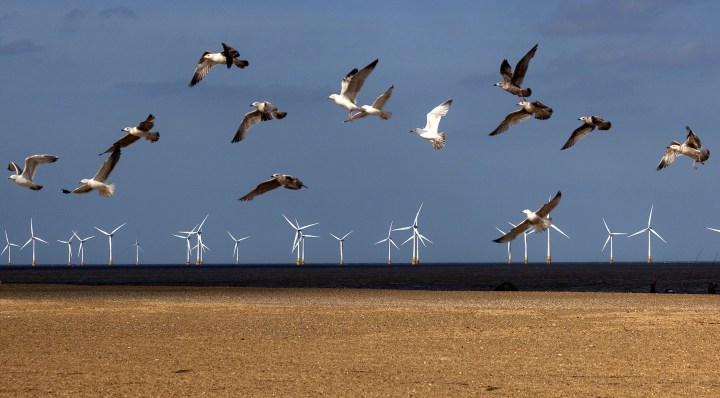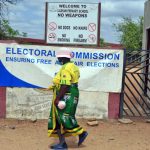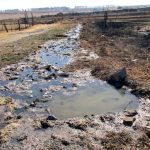TURBINE BLADE HAZARDS
Energy sector explores strategies to limit bird and bat fatalities at wind farms

Fatal bird and bat collisions with rapidly spinning wind turbine blades in South Africa occur more frequently than previously thought and are one of the most significant ecological obstacles linked to wind energy production.
Birdlife South Africa has reported that birds from at least 200 species have had fatal collisions with wind turbines in South Africa and that almost every wind farm in the country has recorded fatalities of threatened and priority species.
However, there are solutions in the works. One is a bird fatality mitigation pilot project that involves painting and patterning turbine blades to improve their visibility and reduce collisions. The South African Wind Energy Association (Sawea) and BirdLife South Africa have encouraged wind farms to test this strategy.
The Umoya Energy Wind Farm, 125km north of Cape Town, is piloting this project.
Dr Rob Simmons, the CEO and co-founder of Birds & Bats Unlimited, said 10 turbines should be painted with a “signal red” colour and 10 turbines should be used as controls (remaining unpainted).
The blade-patterning project was inspired by a similar project at the Smøla wind-power plant in Norway, which “showed a significant reduction in annual [bird] fatality rates”.
In this experiment, one of the three blades on a wind turbine was painted black, resulting in 70% fewer fatalities at the four turbines with painted blades than at the neighbouring (unpainted) control turbines.
Bird fatalities from wind turbine collisions
Samantha Ralston-Paton, the birds and renewable energy project manager at Birdlife South Africa, said that at least 200 bird species have had fatal collisions with wind turbines in SA and that almost every wind farm in the country has recorded fatalities of birds from threatened and priority species.
Wind farms in South Africa are required to monitor their impacts on birds and report this to the Department of Forestry, Fisheries and the Environment, and BirdLife SA.
“We extract the data from the reports and add it to a database of impacts (recording date, species, location, wind farm, survey methods, etc),” she said.
Ralston-Paton said the issue was not so much the impact of individual wind farms on birds but the cumulative effect of multiple wind farms.
The endangered black harrier was a prime example. “The actual number of individuals lost thus far may not seem huge, but by increasing their fatality rate by just three to five birds a year, we will accelerate its time to extinction. The population is already really small — around 1,200 mature individuals,” Ralston-Paton said.
She said it was important to keep in mind that without mitigation, impacts could be ongoing during the 20-year lifespan of a wind farm, and with South Africa’s plans to increase the number of turbines significantly over the next 10 years, mitigations could help some endangered bird species to survive.
Fatalities from collisions with wind turbine blades in South Africa have been recorded in other threatened and priority species, including the Verreaux’s eagle (classified as vulnerable), the Martial Eagle (classified as endangered), the Cape vulture (classified as vulnerable), and the secretary bird (classified as endangered).

According to Birdlife SA, almost every wind farm in South Africa has recorded fatalities of threatened and priority species. ‘WEF’ indicates wind energy facilities. (Graphic: BirdLife South Africa)
“As wind expands into new areas (such as Mpumalanga) new species will emerge as priorities, but raptors (especially eagles and vultures) tend to be the biggest challenge… The overlap of good wind resources and vultures in the Eastern Cape is also a real challenge as there are socioeconomic benefits to wind energy development,” Ralston-Paton said.
“One wind farm reported almost 50 birds killed per turbine per year — mostly swifts (not threatened).”
Bat fatalities from wind turbine collisions
The South African Bat Assessment Association (Sabaa) said that while bats have sophisticated means of detecting their environment and orienting themselves (such as echolocation), there was a concerning number of bat fatalities at wind turbines.
“This is because large turbine blades move too fast to allow bats to avoid collision. Furthermore, echolocating bats may not echolocate on known routes and so may be surprised by the appearance of new turbines in routine flight paths. Bats may also be killed at wind turbines due to barotrauma (internal injuries due to decompression in the zone of low air pressure near moving blades),” the association said.
At the Windaba energy conference in Cape Town this month, Stephanie Dippenaar from Sabaa said that “over 64 species of bats are threatened by wind turbines” and that bat fatalities may outnumber bird fatalities.
Apart from fatalities from collisions with blades and barotrauma, other adverse effects of wind turbines on bats include roost disturbances and/or destruction, the destruction of foraging habitats, the displacement of bats from their foraging habitat and barriers to migration routes.
One solution to combat bat fatalities from wind turbine collisions is bat deterrent technology. At Windaba, NRG Systems explained that bat deterrent systems use ultrasound to discourage bats from entering a turbine’s rotor-swept area.
NRG has successfully tested this technology and implemented systems in South Africa, North America, France and Belgium. DM





















“rapidly spinning”? You’re joking, right?
Wind turbines rotate at between 10 and 20 rpm, so not fast. The speed at the tips of the blades is fast, around 160-280 kph, depending on the size of the turbine and the weather conditions.
A well written article. I saw a yellow billed kite killed by a truck recently. I would think, in general road kill would impact different bird species than those killed by wind turbines. But it would have been useful to compare roadkill numbers and species, with wind turbine kill numbers and species.
Indeed! Also kills by tall glass-faced buildings, by domestic and feral cats and by powerlines.
Each of these categories are well- known to kill hundreds (in some cases thousands) of times as many birds as do modern wind turbines.
Birds face a myriad of threats, including cats, cars and powerlines. There are a number of problems with comparing the total number of birds killed from different activities. Firstly, lumping all species of bird together is not very helpful. We don’t tend to do this for mammals. Would you, for instance, lump mice and rhinos into the same category? The conservation status, biology and the way society values species’ matter.
Comparing the number of species threatened by different activities is more helpful and can help guide conservation action. Invasive species and habitat loss are the biggest threats. However, this does not imply that we can disregard other impacts. Wind energy can help mitigate climate change, which is why it is so important we find solutions, but it does not lesson the significance of the many other pressures biodiversity faces.
Raptors are rather prone to being killed on impact with skyscrapers. Modern wind farms are only erected where studies have been done of bird migratory routes — particularly of threatened species.
The Royal Society for the Protection of Birds seems to have studies the issues –presumably in some detail. To emphasize that wind turbines actually SAVE bird lives (by reducing bird-killing pollution & climate change) they have erected at their headquarters in Bedfordshire a 100 metre wind turbine to supply about half their annual electric consumption.
Hahahahahaha
The above graphic on bird fatality rates by wind turbines is seriously misleading in stating only for wind turbines that the actual fatalities are much higher. Wind turbine fatalities tend to be localized or at least concentrated near the turbine, whereas the results of collisions with vehicles (whether trucks, cars or airplanes) and electric powerlines tend to be much more distributed, and much harder to study or quantify.
Likewise fatalities due to cats.
Like Bruce Sobey, I have seen (more than once) what a collision with a vehicle does to a bird.
I think you misunderstood the graphic. It indicates observed fatality rates at wind turbines in South Africa – i.e. actual bird carcasses found. Those figures have not been adjusted to account for the carcasses overlooked by surveyors, removed by scavengers, or that fell outside the survey area. That is why we indicate that the actual fatality rates are likely to be higher. The point is to show minimum fatality rates recorded at wind turbines, not to make comparisons with other sources of bird fatalities.
What about wind turbines placed out at sea… Would that not be less harmful to bird and bat life? Have seen them off the coast in Brighton, UK… Not wonderful aesthetically to observe on the horizon, but perhaps less harmful to other sentient beings????
Offshore wind farms are considerably more expensive than their onshore wind, so it may be a good few years before we see turbines off our coastline. Much like the approach taken with onshore wind farms, ensuring that offshore wind turbines are situated away from areas frequently used by threatened species will be important. The ocean teems with life and supports a diversity of birds and other wildlife – even bats in certain areas. Albatrosses, known for their expansive wingspans, may be particularly at risk of turbine collisions. Hopefully, by the time offshore wind energy becomes a reality in South Africa, we will have effective technological solutions to mitigate these risks too.
Yet the UK, Denmark, the Netherlands, Germany, Norway, Sweden & others are investing massively in offshore wind farms, and thereby reduced their cost to around 0.5 euros per kWh generated. Well below the cost of coal power from Eskom’s newest plants. With lifetime availablity factors of large offshore plants around 50% — exceeding that of Medupi & Kusile.
One such wind farm even links the power grids of Germany, Denmark and Sweden.
It’s quite obvious you don’t understand or know anything about the topography of SA’s coastline
South Africa coasline implies we have limited opportunities for fixed offshore wind turbines, the type commonly used counries described above. These are only suitable for water depths of less than 50m. Floating wind turbines can be erected in depths between 50 to 1,000m, but are still quite new and more costly.
Samantha Ralston is right to point out that comparing cat or vehicle bird fatalities with wind turbine fatalities is fraught with caveats. Perhaps the biggest is that threatened birds, especially our raptors, are more prone to collisions than most other (non-threatened) species. Cats in South Africa don’t tend to kill many threatened birds, just a lot of smaller passerines. Perhaps the biggest omission from this listing of what kills most is that of climate change itself – the “Elephant in the room” that our renewable energy sector is trying to soften. Birds lose habitat, forage less, seek shade more and incur fitness and population costs to the heat and drought that is enveloping our planet. When the sums are in the costs of climate change to birds are likely to be orders of magnitude higher than the approximately 5000 birds killed by the SA wind industry, or the ~3.5 million birds killed by South Africa’s cats. Whatever plans we can muster to reduce these costs, such as patterning turbine blades to increase their visibility to passing raptors is surely a step in the right direction?
Indeed!
Hahahahahahahahahaha
Why not just revert to reliable nuclear power?